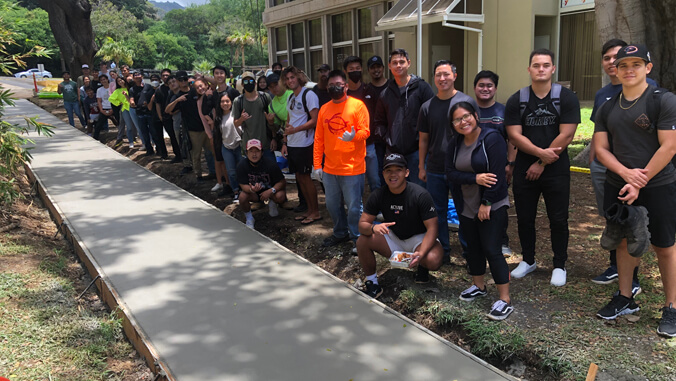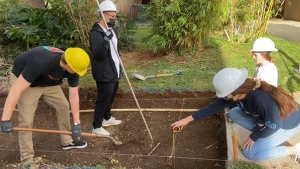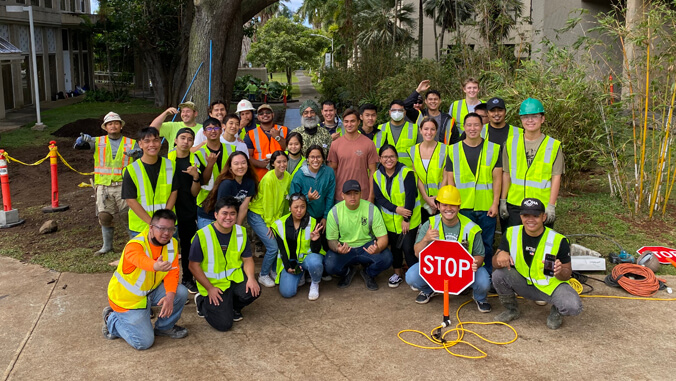
An aging pedestrian walkway on the University of Hawaiʻi at Mānoa campus got a brand-new look while saving the university thousands of dollars, thanks to the hard work of College of Engineering students.
Located between the Queen Liliʻuokalani Center for Student Services and Saunders Hall, the 100-foot walkway became very uneven and filled with potholes through the years, creating a pedestrian hazard. More than 40 students from a civil and environmental engineering construction materials course, under the guidance of Professor Amarjit Singh, took matters into their own hands.

After approval from Campus Operations and Facilities (COPF), students prepared the layout and structural and pavement design for the new walkway in March. The proposal was approved by the Office of Project Delivery in April. The COPF-Buildings and Grounds Management (BGM) Department helped with excavation, heavy equipment, installation of the rebar and partial placement of the aggregate subbase. The students compacted the subgrade and subbase, specified the concrete mix, and fabricated and installed the formwork. The students procured the rebar and lumber and various tools. Hawaiian Cement donated the aggregate and the concrete. Students arranged for a concrete pump truck and then assisted BGM workers to pour and vibrate the concrete. Hensel Phelps contributed two professional masons to make a perfect surface finish.
In total, the students worked with and gathered approvals from UH Mānoa’s Office of Planning and Facilities, Office of Project Delivery, Mānoa Sustainability Office, Facilities Management Office, Buildings and Grounds Management, and the Environmental Health and Safety Office.
Project completed under budget
The students initially budgeted $4,300 for a 40-foot walkway project. However, thanks to the Hawaiian Cement donation and other cost saving measures, the students were able to complete the full 100-foot walkway in approximately $3,500. This saved the university an estimated amount upwards of $40,000, if an outside structural engineering consultant and contractor were hired.
Making a difference on campus

Rumesh Senthilnathan, a junior majoring in civil and environmental engineering, was one of the student leads in the project.
“It was a good feeling to learn what it takes to turn an idea into reality in the real world,” Senthilnathan said. “I had a real taste of what it takes to get everything and everyone on track. The trick was to roll with the punches because nothing was perfect and will never be, but we must strive to make the finished product as close to perfection and humanly possible.”
Senthilnathan credited Singh, teaching assistant Jacob Passoff and Department of Civil and Environmental Engineering lab tech Jonathan Imai with helping to supervise all aspects of the project.
“This was a great learning experience for students who will handle future large-scale construction projects in the state, country, or anywhere in the world,” Singh said. “There was great collaboration between the Facilities Department and the students. This project was a win for UH Mānoa that got a solid walkway to high quality industry standards for minimal cost. The students completed the project well below budget and were ready for the pour one week ahead of schedule. Students learned strategies for effective execution of works. In the end, the stated purpose of the walkway is to improve life on campus one walkway at a time, as well as encourage student learning.”

UH Mānoa Director of Campus Operations and Facilities Blake Araki credited Roxanne Adams, COPF–BGM director; Yosuke Jo, BGM-Landscape Services manager; and Brandon Shima, Office of Project Delivery–design manager with helping to oversee the project from start to finish.
This work is an example of UH Mānoa’s goals of Enhancing Student Success (PDF) and Excellence in Research: Advancing the Research and Creative Work Enterprise (PDF), two of four goals identified in the 2015–25 Strategic Plan (PDF), updated in December 2020.
—By Marc Arakaki


